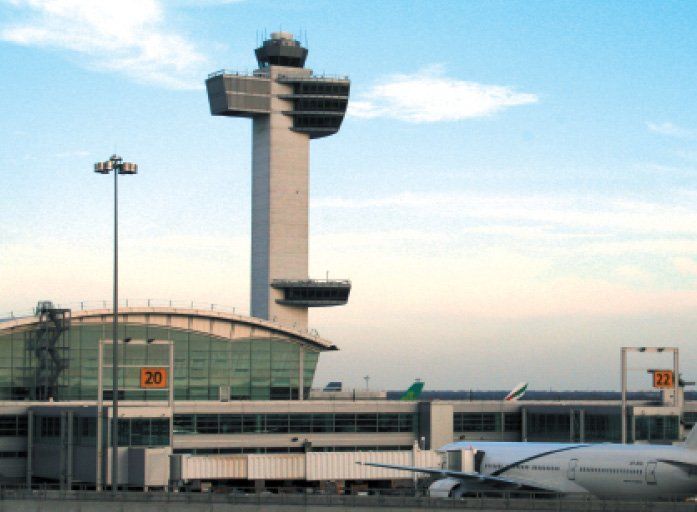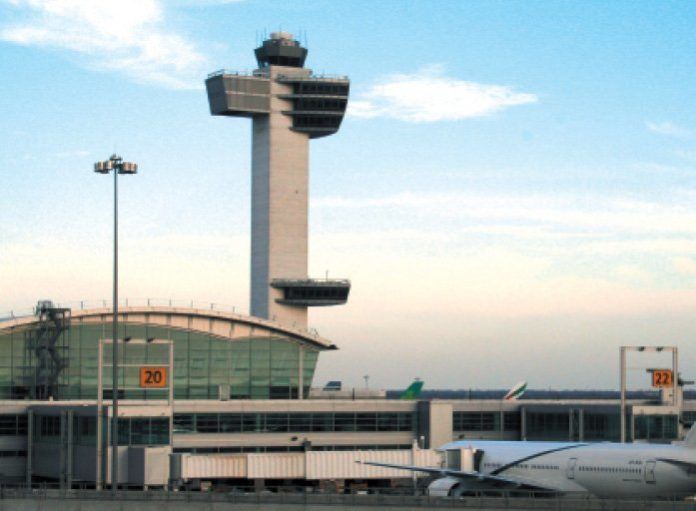A reader wrote us recently about a pinch he found himself in during an IFR flight. He departed Easterwood Field (KCLL) destined for David Wayne Hooks Memorial (KDWH) in Houston. His departure clearance was “cleared to David Wayne Hooks Airport via radar vectors.” Easy enough. KDWH was his clearance limit.
Handed to the final Houston Approach controller, he requested direct JIDUK, the IAF for the RNAV RWY 35L approach. The controller issued, “expect the RNAV RWY 35L approach, proceed direct JIDUK, descend and maintain 2000 feet.”
Now for the pinch. The pilot reached JIDUK without an approach clearance. The frequency was congested, making him effectively NORDO. He had to do something. But what?
Cleared to the IAF
One appealing answer is before reaching JIDUK, squawk 7600 and announce at the next break on the frequency that he was commencing the approach. If no reply from Approach, then contact tower and tell them. Anything is better than proceeding blind.
In his letter, he asked whether JIDUK was his new clearance limit. It was, replacing KDWH. Lacking any instruction, what should he do at JIDUK?
Effectively having lost communication, 91.185 (c)(3)(i) tells us what to do: “When the clearance limit is a fix from which an approach begins, commence descent or descent and approach as close as possible to the estimated time of arrival as calculated from the filed or amended (with ATC) estimated time en route.”
His case is bolstered by 91.185 (c)(1)(iii), which mandates following “the route that ATC has advised may be expected in a further clearance.” He was told to expect the RNAV RWY 35L approach. Legally, he’s covered.
He considered entering a standard hold at JIDUK. It would be hard to argue this decision, except it has no legal basis unless he invokes emergency authority. If someone else is ahead on the approach, it’s smart. If someone is headed toward JIDUK behind him, it’s not so smart.
Controllers cherish predictability. If he flows onto the approach, that’s predictable. Entering an unpublished hold is not.
AIM 4-4-3.e.3. lays out conventional instructions for uncharted holds in the absence of ATC instruction. This section is more applicable to an en-route hold or a short-range clearance where ATC communication is unavailable. However, a note at the end of the section refers right back to 91.185 that includes specific instructions in an approach context.
Clearance Limits
Formally, a clearance limit is the fix, point, or location to which an aircraft is cleared when issued an air traffic clearance. The clearance issued prior to departure normally authorizes flight to the airport of intended landing. A clearance limit is always preceded by the words, “Cleared to…” as above.
When the clearance limit is the airport of intended landing, the clearance should contain the airport name followed by the word “airport.” A clearance limit may also be a NAVAID, intersection, or waypoint. If the type is known, the clearance should contain its type. Some airports and collocated or nearby NAVAIDs have long had the same name and/or identifier, causing confusion. In recent years, some NAVAIDs have been renamed to eliminate such mix-ups.
En-Route Clearance Limits
If issued an en-route clearance limit, you will be given holding instructions. If the pattern is charted, and they rarely are, you might be issued, “Hold east as published.” Most moving map displays such as the G1000 and GTN series do not show published holds, necessitating a chart, but ATC will issue full holding instructions if requested. The FAA frowns on unpublished holds, saying that “only those holding patterns depicted on U.S. government or commercially produced charts which meet FAA requirements should be used.” This is another reason why rolling your own at JIDUK, is a shaky idea.
An en-route hold or clearance beyond the holding fix is supposed to be issued at least five minutes before reaching it. Lacking further clearance, the aircraft should reduce speed so the aircraft will cross the holding fix at or below maximum holding speed. Enter a standard hold on the course used to approach the fix. Report entering and leaving the clearance limit including altitude and time.
One trick that can reduce time in the hold or even eliminate it is by reducing speed (with ATC concurrence), even while en route before reaching the fix. Try it; it might work.
Short-Range Clearances
Normally, an aircraft should be cleared for its entire route. Sometimes a short-range clearance is issued to a departing aircraft authorizing IFR flight to a fix short of destination while ATC assembles a complete clearance. Often a short-range clearance is issued to a fix within or just outside the departure terminal area. When the pilot is handed off to a Center controller, they issue the full-route clearance.
Communications Failure
No discussion about clearance limits would be complete without dissecting 91.185, IFR operations: Two-way radio communications failure, the reg everyone seems to hate, specifically subparagraph (3). The destination airport is our clearance limit because you have been cleared to it.
This section states, “(3) Leave clearance limit. (i) When the clearance limit is a fix from which an approach begins, commence descent or descent and approach as close as possible to the expect-further-clearance time if one has been received, or if one has not been received, as close as possible to the estimated time of arrival as calculated from the filed or amended (with ATC) estimated time en route.”
Sounds nice, but it doesn’t work. Since the clearance limit is the destination airport, very few approaches start there. An airport is never used as a fix in IFR. A fix is an intersection, waypoint or NAVAID. Moreover, receiving an EFC time in advance is simply silly. This would also presume the issuance of holding instructions. Why would a controller issue these things since lost communication cannot be predicted?
All of this makes subparagraph (c)(3)(i) largely useless. But subparagraph (c)(3)(ii) is another matter:
“(ii) If the clearance limit is not a fix from which an approach begins, leave the clearance limit at the expect-further-clearance time if one has been received, or if none has been received, upon arrival over the clearance limit, and proceed to a fix from which an approach begins and commence descent or descent and approach as close as possible to the estimated time of arrival as calculated from the filed or amended (with ATC) estimated time en route.”
In this scenario, you would be expected to hold (somehow) over the airport until your (nonexistent) EFC time expires or cross over the airport to a fix from which an approach begins, and then begin your approach as close as possible to your ETA (if you remember it.)
This could work out well, especially if there is a published hold, such as a hold-in-lieu of a procedure turn that is part of the approach. All RNAV approaches have one, and many ground-based approaches do as well. You could hang your hat at altitude and commence descent once ETA occurs or immediately if late.
But which approach? Hopefully you have an idea as to wind direction. It may be that your transmitter is out, but maybe you can receive AWOS/ASOS and ATC. In that case, listen to ATC and then IDENT as instructed if your transponder still works. There are many alternatives such as ADS-B In which the FAA acknowledges in AIM 6-4-1.a.: “It is virtually impossible to provide regulations and procedures applicable to all possible situations associated with two-way radio communications failure.”
ATC will close the airport until they know what you will do. Holding, especially galling because it is pointless, stops everything. ATC is particularly sensitive to NORDO aircraft because to them you are out of control. It’s also an issue because it could be a first indication of a hijacking or national security threat.
In a 2011 NASA simulation study, a retired supervisor and former terminal-area traffic manager worked three times as long, and twice as hard, on NORDO problems as on medical events. Medical events let him set up a plan and play it out. However, the NORDO aircraft’s actions were unknown, even though pilots were expected to follow established procedure. Hence the NORDO required greater monitoring of feeder and final radar positions.
In hindsight, the larger number of adjustments and plan changes that the supervisor made during NORDO events highlights that NORDOs, in general, were the least elastic emergencies. Not only was a NORDO inherently less predictable, but it was also less flexible because controllers could not redirect the problem aircraft, forcing the supervisor to adjust the schedule around it.
Emergency Action
Many pilots disdain these rules as onerous, unnecessarily time-consuming and complex. Of course, you have an out. AIM 6-4-1.a. continues: “During two-way radio communications failure, when confronted by a situation not covered in the regulation, pilots are expected to exercise good judgment in whatever action they elect to take. Should the situation so dictate they should not be reluctant to use the emergency action contained in 14 CFR Section 91.3(b).”
This rule allows you to decide whether the radio failure constitutes an emergency. You need not declare one. ATC can invoke an emergency without your permission and not even tell you. If you elect to go straight to an IAF and shoot an approach, that’s your privilege. AIM 6-4-1.c. says: “A pilot experiencing two-way communications failure should (unless emergency authority is exercised) comply with 14 CFR Section 91.185.” ATC anticipates you will comply with 91.185—but you don’t have to.
Let’s Be Practical
If you experience two-way radio failure, could that be a harbinger of a more serious electrical problem? Maybe you’re short on fuel, IMC or simply stressed out. Regardless, time is working against you. I’d personally want to get on the ground as soon as possible with pilot, passengers and airplane intact. Let everyone get back to work. The FAA can come after me later, waving my ASRS report in defiance.
Oh, and if I am faced with the same issue as our reader at the beginning, I’d just continue right into the approach, relying on what I was told to expect.

Fred Simonds, CFII is a big fan of the FAA and following the regulations, but not of blindly following them in the face of good common sense.
Clearance Limit Back Story
Digging beyond the main article, let’s look at the complex and confusing 91.185(c)(3)(i). First, it made some sense before widespread radar coverage, with separation based on pilot position reports. Clearance limits short of the airport were more common to maintain spacing. The illogic of flying over the airport is that many airports lack navaids on the airport, making the use of clumsy VOR cross-radials necessary back in the day. No airport serves as a fix from which an approach begins because airports in IFR cannot be fixes. Subparagraph (c)(3)(i) is essentially useless because the clearance limit airport cannot be a fix.
Subparagraph (c)(3)(ii) is more workable. You arrive over the airport. It is not a fix from which an approach begins. Since you have no comm you are unlikely to have an EFC time, in which case you fly over the airport to a fix from which an approach begins—pick one, using whatever resources you have. So far, so good. What you do there is unspecified if you have not yet reached your filed ETA. The unspoken expectation is that you hold at the IAF at your last assigned altitude. Hold outside the IAF so that when ETA is reached, you will descend in the hold and then smoothly commence the approach facing the airport. That’s the by-the-book answer.
But in Reality…
More practically, ATC does not want you flying a holding pattern while it’s diverting traffic everywhere to avoid a conflict. You have unintentionally shut the airport down. When you reach an IAF of your choosing, ATC will know which approach you intend to use. At the IAF, use your emergency authority and begin descent. ATC will see you descending and make sure the way is clear. Look for a green light gun signal from the tower, but these can be notoriously hard to see in weather. Unless you see a conflict, land. Everyone will be happier, especially you. Clear the runway and stop. Do not taxi without permission.
Challenges
Since 2009, there have been about five challenges to this rule. In the latest iteration, our past editor, Jeff Van West, wrote the Office of Chief Counsel in late 2017, arguing that 91.185 (c)(3)(ii) is inconsistent with current air traffic practices and creates an unnecessary hazard. Jeff contended that since most IFR clearances issued by ATC have a clearance limit of the destination airport, the current interpretation requires an aircraft to hold over the airport until ETA and then descend and commence final approach. Jeff asserted that doing so could affect a pilot’s anxiety level and preparedness for the approach and affect other inbound aircraft. Jeff suggested that ATC be prepared for an immediate approach instead, because the transponder hits tell ATC its position, and could be considered an ETA update.
Jeff cited the fact, and the FAA agreed, that the regulation is rarely invoked due to improved technology that ensures pilot-ATC communication is not lost. The FAA then reasserted 91.185(c)(3)(ii) citing its necessity to ensure the safety of the National Airspace System when a pilot cannot communicate with ATC. They do not consider a working transponder as a substitute for two-way communication between the pilot and ATC, or for the ETA filed in the flight plan on which ATC relies to make other safety-based determinations. For at least the fifth time, the FAA affirmed its previous interpretations of 91.185(c)(3). And that’s where it rests today. —FS






Great article. However, I would regard the destination airport as the clearance limit.
As you state in the article, “A clearance limit is always preceded by the words, “Cleared to…” as above.”
If the IAF were a clearance limit, ATC should have given a EFC time.
I would proceed to the the IAF and commence the approach.
I agree with David. The pilot was “cleared direct to…” which is a route instruction. If JIDUK was to be a clearance *limit* the phraseology would be “cleared to JIDUK via direct”. Remember the CRAFT mnemonic.
I was taught to always plan an IFR route with the last fix prior to the airport being an IAF for the likely approach. That way in a NORDO situation I’m already set up for an approach and there’s none of this debate about whether to fly to the airport first at altitude and then proceed to an approach. Anyone else do this?
I agree with the previous comments. I would not have interpreted that instruction as a change to the clearance limit. In fact, I often am given radar vectors on departure which are different than my cleared as filed route. When they are done vectoring me, I sometimes get a “proceed direct” to a navaid in my original route with no “resume own navigation” after that. Should I consider that a revised clearance limit and hold there? Pretty sure ATC would lose their mind if I did that.
I realize, based on the date of the article, that I am a couple of years late but this subject comes up frequently in flight checks and instrument flight training.
“This could work out well, especially if there is a published hold, such as a hold-in-lieu of a procedure turn that is part of the approach. All RNAV approaches have one, and many ground-based approaches do as well.”
This statement is not accurate. See RNAV 19 @ KUKF- and there are others like it. There is no Procedure Turn depicted and no Hold en lieu of a PT so there are times when you would hold at the IAF where no hold is depicted. Additionally you would also want to check the MSA before beginning descent unless you are established on a published segment of the approach.
The whole concept of 91.185 is not that complicated and, as a former Air Traffic Controller, 121 pilot and DPE, it seems to me that it provides exactly what was intended – a clear and succinct procedure to use if communication is lost. I continue to be amazed at the number of rated, high time instrument pilots who have no idea what a clearance limit is or why the term exists and it’s implications in the event that things don’t go as planned. That said there is much that I don’t know so please take my comments as intended. None of us are the Yoda of aviation.